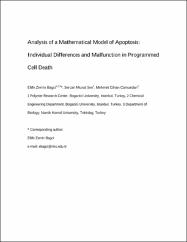| dc.contributor.author | Bağcı, Elife Zerrin | |
| dc.contributor.author | Sen, S. Murat | |
| dc.contributor.author | Çamurdan, Mehmet C. | |
| dc.date.accessioned | 2022-05-11T14:28:29Z | |
| dc.date.available | 2022-05-11T14:28:29Z | |
| dc.date.issued | 2013 | |
| dc.identifier.issn | 1387-1307 | |
| dc.identifier.issn | 1573-2614 | |
| dc.identifier.uri | https://doi.org/10.1007/s10877-013-9468-z | |
| dc.identifier.uri | https://hdl.handle.net/20.500.11776/6843 | |
| dc.description | SCAI 10th International Conference on Complexity in Acute Illness (ICCAI) -- SEP, 2011 -- Bonn, GERMANY | en_US |
| dc.description.abstract | Apoptosis is an important area of research because of its role in keeping a mature multicellular organism's number of cells constant, hence, ensuring that the organism does not have cell accumulation that may transform into cancer with additional hallmarks. Firstly, we have carried out sensitivity analysis on an existing mathematical mitochondria-dependent apoptosis model to find out which parameters have a role in causing monostable cell survival, which may, in turn, lead to malfunction in apoptosis. We have then generated three base parameter sets that represent healthy cells. These parameter sets were built by changing the sensitive parameters while preserving the bistability. For each base set, we varied the proapoptotic and antiapoptotic production rates, to yield new sets for the cells that have malfunctioning apoptosis. In a hypothetical cell model, we simulated caspase-3 activation by numerically integrating the governing ordinary differential equations of a mitochondria-dependent apoptosis model. These simulations were carried out for four potential treatments, namely: (1) proteasome inhibitor treatment, (2) Bcl-2 inhibitor treatment, (3) IAP inhibitor treatment, (4) Bid-like synthetic peptides treatment. The results suggest that the proteasome inhibitor treatment is the most effective treatment, though it may have severe side effects. For this treatment, the amount of proteasome inhibitor needed for caspase-3 activation may be different for hypothetical cells with a different pro- or anti-apoptotic protein defect. It is also found that caspase-3 can be activated by Bcl-2 inhibitor treatment only in those hypothetical malfunctioning cells with Bax deficiency but not in others. These results are in line with the view that molecular heterogeneity in individuals may be an important factor in determining the individuals' positive or negative responses to treatments. | en_US |
| dc.description.sponsorship | Soc Complex Acute Illness (SCAI) | en_US |
| dc.language.iso | eng | en_US |
| dc.publisher | Springer Heidelberg | en_US |
| dc.identifier.doi | 10.1007/s10877-013-9468-z | |
| dc.rights | info:eu-repo/semantics/openAccess | en_US |
| dc.subject | Simulations of apoptosis malfunction | en_US |
| dc.subject | Variability in individuals | en_US |
| dc.subject | Treatments of malfunction in apoptosis | en_US |
| dc.subject | Caspase Activation | en_US |
| dc.subject | Pathway | en_US |
| dc.subject | Cancer | en_US |
| dc.subject | Mitochondrial | en_US |
| dc.subject | Bistability | en_US |
| dc.subject | Mechanisms | en_US |
| dc.subject | Simulation | en_US |
| dc.subject | Resistance | en_US |
| dc.subject | Dynamics | en_US |
| dc.subject | Survival | en_US |
| dc.title | Analysis of a mathematical model of apoptosis: individual differences and malfunction in programmed cell death | en_US |
| dc.type | proceedingPaper | en_US |
| dc.relation.ispartof | Journal of Clinical Monitoring and Computing | en_US |
| dc.department | Fakülteler, Fen Edebiyat Fakültesi, Biyoloji Bölümü | en_US |
| dc.authorid | 0000-0001-5920-0400 | |
| dc.identifier.volume | 27 | en_US |
| dc.identifier.issue | 4 | en_US |
| dc.identifier.startpage | 465 | en_US |
| dc.identifier.endpage | 479 | en_US |
| dc.institutionauthor | Bağcı, Elife Zerrin | |
| dc.relation.publicationcategory | Konferans Öğesi - Uluslararası - Kurum Öğretim Elemanı | en_US |
| dc.authorscopusid | 8754351000 | |
| dc.authorscopusid | 54279389500 | |
| dc.authorscopusid | 6604017391 | |
| dc.authorwosid | Bağcı, Elife Zerrin/A-9660-2016 | |
| dc.identifier.wos | WOS:000321261400012 | en_US |
| dc.identifier.scopus | 2-s2.0-84879552009 | en_US |
| dc.identifier.pmid | 23604638 | en_US |



















